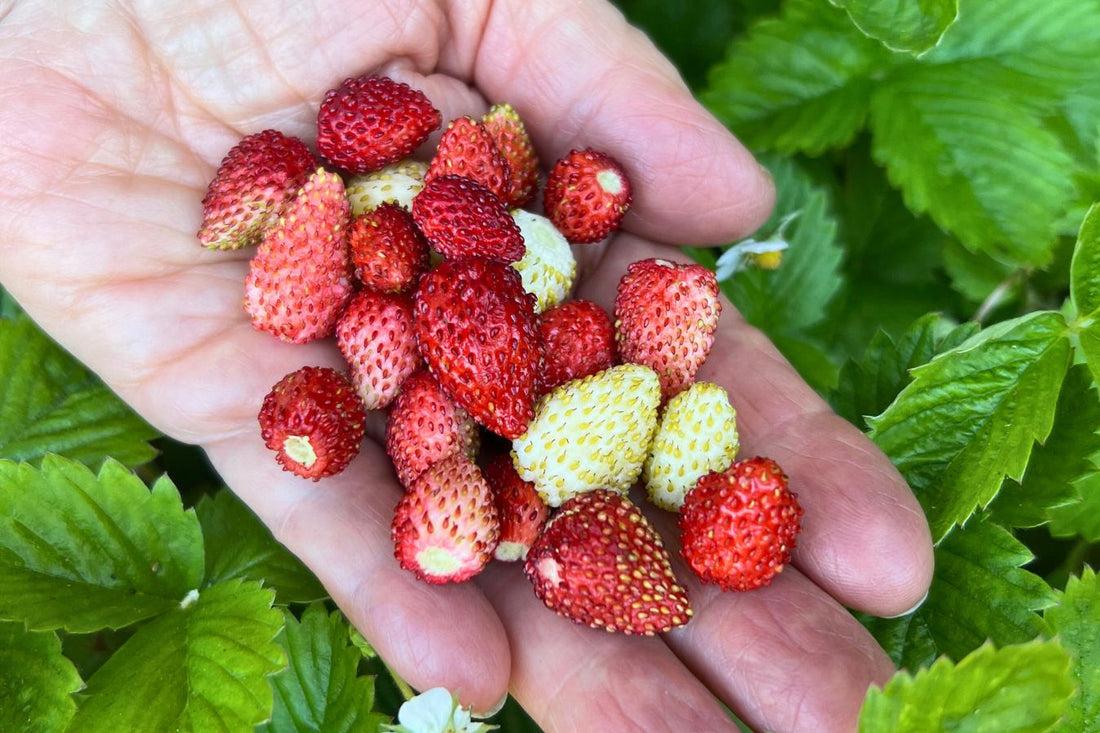
Also known by their romantic French name, Fraises des Bois, these charming and well-behaved perennial plants yield continuous harvests of tiny, 3/4 inch berries with an intensely concentrated flavor I can only describe as truly ambrosial.
In France, Alpine strawberries are carefully hand harvested and sold as a sought after seasonal specialty to top perfect individual custard tarts at Paris patisseries. In fine restaurants, they are served in exquisite stemware topped with creme fraiche and candied violets.
The jewel-like fruits of Alpine strawberries (Fragaria Vesca Sempervirens) are a special delicacy you can enjoy every summer. To me their flavor combines the essence of strawberries, roses and pineapples. Also known by their romantic French name, Fraises des Bois, these charming and well-behaved perennial plants yield continuous harvests of tiny, 3/4 inch berries with an intensely concentrated flavor I can only describe as truly ambrosial.
Alpine strawberries are cultivated strains of wild or woodland strawberries and are reported to have been transplanted into domestic gardens as early as the 12th century – which is easy to understand as their aroma and flavor are unmatched as garden berries. Our cultivar is of French origin, and the improved Alpines we grow today were first introduced in Paris over 100 years ago.
Alpines can grow in full sun, although in very hot weather areas, they will also thrive in half day sun or an area of dappled shade. Like other berries, they love a rich, fertile, and above all, well drained soil. Alpines need little special care beyond consistent moisture and occasional feeding. Mulching the plants to tuck them in and keep roots moist is a good strategy unless snails or slugs are a menace in your garden.
These hardy, evergreen plants are carefree because, unlike regular strawberries, they do not self propagate by sending out runners. They'll stay wherever you plant them gradually growing into soft leafy mounds about a foot in diameter and height. After several seasons, mature plant crowns will multiply and can be divided in early spring to double or triple your number of plants. Plants bear fruit the first season after sowing. Feed and water regularly and plants will continue to fruit for 2 to 4 years.
Properly located, plants will bear a continual summer long crop of deep crimson pointed petite berries full of flavor and fragrance. Pick and enjoy these delightful petite perfumed berries when they turn a deep red and give slightly to the touch.
Alpine plants with their green, serrated little leaves, white flowers and bright red delectable, berries are neat, attractive and very ornamental. The plants are perfect in windowboxes or hanging baskets, or as a handsome edging plants along a garden path or flower border and are equally at home as rock garden plants, in window boxes, patio containers, or in cascading from strawberry pots.
Seven or eight mature little Alpine plants will yield about a cup of berries several times a week on a continuous basis throughout the summer. They are even more special just because the harvest is sparing, so I share them only with those who appreciate them as much as I do. Pick and enjoy these delightful petite perfumed berries when they turn a deep red and give slightly to the touch.
It is difficult to resist eating all of the these tempting morsels right from the plants so chances are not many ever make it into the kitchen! For special occasions, serve them in feather light desert crepes or use them to top freshly made Belgian waffles. If you have enough, I have found that these sweet gems make heavenly little pots of glowing jam. The fruits have more pectin than regular strawberries, so making the jam is easy and quick.
Still, my favorite way to enjoy Alpines' elusive and richly seductive flavor is to eat them fresh from the garden. Sprinkle a handful over your morning cereal or nestle the ruby colored berries on tiny tarts or cakes served in glass goblet with a sinful dollop of real whipped cream – a truly splendid indulgence.
